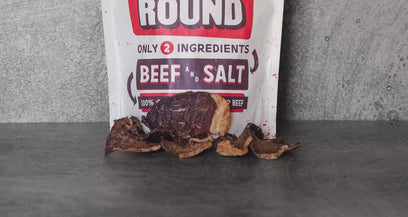THE CARNIVORE DIET BENEFITS




In the age of information, consumers are becoming increasingly enlightened about the origins of their food. The promise of sustainable and ethically produced goods resonates deeply with many, leading them to a term that's gained momentum: regenerative agriculture.
But if it's such a beacon of hope for sustainable food production, why is regenerative agriculture bad according to some individuals? The truth unfolds not in the farm fields nourished by these practices, but in the boardrooms of commercial farming giants.
Because while regenerative agriculture might be a ray of sunshine for consumers, small-scale farmers, and our precious lands, it casts a shadow on the profit-driven model of big agriculture. But is that such a bad thing?
Dive in with us, as we unearth the reasons why what's great for our land and its inhabitants might just be 'bad news' for the behemoths of the farming world. First, what is regenerative agriculture?
Is Regenerative Agriculture Bad?
If you’ve already read about the pros and cons of regenerative agriculture, you may be confused…why is regenerative agriculture bad? It’s not - let’s be clear.
The benefits of regenerative farming dramatically outweigh any of the ‘downsides’ - whether it be the higher cost of food for consumers, the initial investment for farmers to transform their operation, etc.
That being said, let’s start by looking at the basics of how regenerative agriculture works before addressing this misconception directly.
Understanding Regenerative Agriculture
Regenerative agriculture is a movement in how we view and interact with the land. Traditional agricultural methods often focus on extracting as much as possible from the soil.
In contrast, regenerative farming techniques seek to restore, renew, and rejuvenate. This method prioritizes soil health, aiming to increase biodiversity, enrich ecosystems, and sequesters carbon. It goes beyond the standard practices of sustainable agriculture, aiming not just to sustain but to revitalize.
These practices may include crop rotation, cover crops, conservation tillage, agroforestry, regenerative agriculture fertilizer, and managed grazing. All these aim to support the ecosystem, leading to resilient crops and healthier livestock without the over-reliance on chemical fertilizers and pesticides.
Misconceptions Surrounding Regenerative Agriculture
Given its holistic and eco-friendly approach, you might be wondering - how can something so good be deemed bad? The misconceptions often arise from a lack of understanding or, sometimes, deliberate misinformation. Here are a few of the common misunderstandings:
- It's inefficient: A widespread belief is that regenerative agriculture can't produce food at the scale needed to feed the global population. However, evidence suggests that these practices can yield just as much, if not more, than conventional methods - especially in the long run as soil health improves.
- It's just a trend: Some dismiss regenerative agriculture as just another 'buzzword' in the ever-evolving landscape of health and sustainability. However, it's rooted in time-tested agricultural practices that indigenous communities have been using for centuries.
- It's expensive: While transitioning to regenerative methods might require an initial investment, the long-term benefits in terms of reduced input costs, healthier soil, and potential for premium product pricing make it economically viable.
In reality, regenerative agriculture isn't bad. Quite the opposite - it offers a path to a more sustainable and harmonious relationship between humans and the land.
But when you add commercial farming giants into the equation, the perspective shifts. And that's where our exploration takes a fascinating turn. So, let’s take a look at why regenerative agriculture is bad from the viewpoint of Big Agriculture.
Why is Regenerative Agriculture Bad For Commercial Farming?
The question isn't about why regenerative agriculture is bad - it's not. Instead, we want to look at how it challenges the established norms and practices of large-scale commercial farming.
The conflict arises from contrasting goals: one is rooted in restoration and rejuvenation, while the other has been predominantly profit-driven.
The Profit-Driven Model of Big Agriculture
Commercial agriculture has been dominated by a few major players for decades who have streamlined their operations to maximize yields, and by extension, profits.
This drive for efficiency comes at the expense of the land, leading to soil degradation, loss of biodiversity, and increased greenhouse gas emissions.
The tools of the trade for these commercial giants often involve heavy machinery, genetically modified organisms (GMOs), chemical fertilizers, and pesticides - all designed to produce vast amounts of food in the shortest time possible.
Regenerative practices challenge this approach, emphasizing quality, health, and environmental balance over sheer quantity. This puts the entire foundation of commercial agriculture at peril. And, much of this can be attributed to a growing change in what consumers want in a food supply system.
The Shift in Consumer Demand: Transparency and Ethical Practices
Consumers are becoming increasingly conscious of the environmental and ethical implications of their food choices. They're looking for products that are not only nutritious but also cultivated in ways that are beneficial, or at least non-harmful, to the planet.
This rising demand for transparency means that big agriculture firms can no longer hide behind obscure supply chains. They are now being held accountable for their practices, pushing them to either adapt or face the consequences of a shrinking customer base.
Economic Impacts: Short-Term Loss vs Long-Term Gain
Transitioning to regenerative agriculture methods often requires an upfront investment in training, resources, and sometimes even land rehabilitation.
For large corporations focused on quarterly profits and shareholder satisfaction, such investments can be hard to justify, even if they lead to long-term gains in terms of sustainability, reduced input costs, and potential premium product pricing.
How Regenerative Agriculture Disrupts the Status Quo
So, knowing all this, why is regenerative agriculture abd for Big Ag? At its core, regenerative agriculture is a call for a paradigm shift. It's a move away from extractive practices that deplete resources and towards a more symbiotic relationship with nature.
This doesn't just challenge the technical and economic aspects of big agriculture - it challenges its very ethos.
For commercial farming entities set in their ways, adapting to this new model is a seismic shift. It's not just about changing practices but about transforming an entire mindset, from one of dominance over nature to one of collaboration with it.
In essence, regenerative agriculture doesn't fit the mold of traditional commercial farming. It doesn't play by the established rules, and that's precisely why it's seen as a threat by some in the big agriculture sector.
Regenerative Agriculture: The True Winners and Losers
As the agricultural world takes a pivotal turn, regenerative practices stand as a beacon of hope for many. But like any significant shift, there are those who benefit and those who must re-evaluate their position.
To truly grasp the transformative power of regenerative agriculture, we must explore who stands to gain the most and who might find themselves challenged by this evolution.
Benefits for Consumers
One of the most compelling advantages of regenerative agriculture is the potential increase in the nutritional value of the produce. Healthier soils imbued with organic matter often yield crops that are richer in essential vitamins, minerals, and antioxidants.
Following a regenerative agriculture diet is also safer. By reducing or eliminating the use of chemical pesticides and fertilizers, regenerative practices can lead to foods with fewer harmful residues.
Plus, regenerative agriculture offers peace of mind for those who value the ethics behind their purchases. It's an assurance that the land is treated with respect, and ecosystems are nurtured rather than exploited.
Benefits for the Land
Regenerative methods prioritize soil health, ensuring it's rich in organic matter, teeming with beneficial microbes, and less prone to erosion. Healthy soils also act as carbon sinks, capturing more carbon dioxide from the atmosphere.
One of the cornerstones of regenerative agriculture is promoting biodiversity. By cultivating a variety of plants and employing practices like crop rotation, farms can become thriving ecosystems, attracting beneficial insects, birds, and other wildlife.
And, regenerative farms often have better water retention capabilities, reducing the need for irrigation. This not only conserves a precious resource but also reduces the farm's impact on local water systems.
Benefits for Farmers
Farmers stand to gain from making the switch to a regenerative operation, too. Wait…is regenerative farming profitable? Yes - it sure is!
As the land regenerates and becomes more fertile naturally, farmers can reduce their dependence on synthetic fertilizers and pesticides. Over time, this can result in significant savings.
Farmers also enjoy peace of mind when running a regenerative operation. That‘s because regenerative practices, by their very nature, make farms more resilient. They can better withstand the challenges posed by droughts, floods, and pests, ensuring a more stable yield.
With the rising consumer demand for ethically produced and organic foods, farmers practicing regenerative methods may find they can charge premium prices for their produce. Moreover, the narrative of caring for the land and producing high-quality crops can be a powerful marketing tool.
Showing Your Support for the Movement: What Can You Do Now?
We have a longer, more exhaustive resource comparing and contrasting regenerative agriculture vs conventional agriculture if you’d like to learn more. But now that you know why regenerative agriculture is important, let’s talk about what you can do to influence change. Here is how to support regenerative agriculture:
- Educate Yourself and Others: Knowledge is power. By understanding the principles and benefits of regenerative agriculture, you can engage in informed discussions, dispel myths, and be a beacon of information within your community.
- Choose Regenerative Products: Every purchase you make is a statement of your values. When you opt for regenerative agriculture products, you're sending a clear message about the kind of agricultural system you want to support. Our carnivore chips can be a direct way to back these practices. Our commitment to regenerative products not only promises you quality but also the assurance that you're contributing to a more sustainable food system. Whether you simply want to make a difference or you’re on a strict diet like keto vs carnivore, these are the best 0 carb snacks.
- Support Local Farmers: Farmers' markets and local co-ops are often treasure troves of regenerative products. By shopping here, you’re directly supporting small-scale farmers who prioritize the health of the land over mass production.
- Advocate for Change: Whether it's signing petitions, joining community groups, or even writing to local representatives, raising your voice can have a profound impact. Policies often change when there's a groundswell of public support behind them.
- Practice Regenerative Principles at Home: If you have a garden, even a small one, try incorporating regenerative practices. This could be as simple as composting kitchen waste, practicing crop rotation, or planting diverse crops. Learn more about how to do regenerative agriculture in our blog.
Knowing why regenerative agriculture is bad for big ag, it’s clear to see what makes it so great for everyone else - from farmers who care for the land to the consumers who enjoy the fruits of their labor.
That being said, put your money where your mouth is today by shopping with a brand that shares your same values - Carnivore Snax!
Bringing Our Conversation on Why Regenerative Agriculture is Bad for Big Ag to a Close
While regenerative agriculture might pose challenges to the established profit-driven models of big agriculture, it's a clarion call for us consumers to dictate the change we wish to see.
Learn more about the shift towards regenerative farming in our blog, with resources on regenerative agriculture history, regenerative cattle farming, regenerative agriculture vs permaculture, water benefits of regenerative agriculture, agroecology vs regenerative agriculture, and more.
Otherwise, as we draw our conversation on why regenerative agriculture is bad to a close, remember this: your choices have power. By understanding the landscape, acknowledging the real winners in regenerative practices, and making conscious buying decisions, you're championing a brighter agricultural future.

























